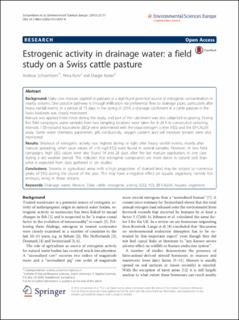Please use this identifier to cite or link to this item:
https://doi.org/10.21256/zhaw-3773| Publication type: | Article in scientific journal |
| Type of review: | Peer review (publication) |
| Title: | Estrogenic activity in drainage water : a field study on a Swiss cattle pasture |
| Authors: | Schönborn, Andreas Kunz, Petra Koster, Margie |
| DOI: | 10.21256/zhaw-3773 10.1186/s12302-015-0047-4 |
| Published in: | Environmental Sciences Europe |
| Volume(Issue): | 27 |
| Issue: | 17 |
| Issue Date: | 2015 |
| Publisher / Ed. Institution: | Springer |
| ISSN: | 2190-4707 2190-4715 |
| Language: | German |
| Subjects: | Estrogenic activity; Dairy manure; Drainage; Aquatic system |
| Subject (DDC): | 333: Economics of land and resources 630: Agriculture |
| Abstract: | Background: Dairy cow manure applied to pastures is a significant potential source of estrogenic contamination in nearby streams. One possible pathway is through infiltration via preferential flow to drainage pipes, particularly after heavy rainfall events. In a period of 73 days in the spring of 2010, a drainage catchment in a cattle pasture in the Swiss lowlands was closely monitored. Manure was applied three times during the study, and part of the catchment was also subjected to grazing. During five field campaigns, water samples from two sampling locations were taken for 4–24 h in consecutive sampling intervals. 17β-estradiol equivalents (EEQ) were determined with the yeast estrogen screen (YES) and the ER-CALUX assay. Some water chemistry parameters, pH, conductivity, oxygen content and soil moisture tension were also monitored. Results: Washout of estrogenic activity was highest during or right after heavy rainfall events, shortly after manure spreading, when peak values of >10 ng/l EEQ were found in several samples. However, in two field campaigns, high EEQ values were also found 14 and 28 days, after the last manure application, in one case during a dry weather period. This indicates that estrogenic compounds are more stable in natural soils than what is expected from data gathered in lab studies. Conclusions: Streams in agricultural areas with a high proportion of drained land may be subject to numerous peaks of EEQ during the course of the year. This may have a negative effect on aquatic organisms, namely fish embryos, living in these streams. |
| URI: | https://digitalcollection.zhaw.ch/handle/11475/7253 |
| Fulltext version: | Published version |
| License (according to publishing contract): | CC BY 4.0: Attribution 4.0 International |
| Departement: | Life Sciences and Facility Management |
| Organisational Unit: | Institute of Natural Resource Sciences (IUNR) |
| Appears in collections: | Publikationen Life Sciences und Facility Management |
Files in This Item:
| File | Description | Size | Format | |
|---|---|---|---|---|
| s12302-015-0047-4.pdf | 2.97 MB | Adobe PDF |  View/Open |
Show full item record
Schönborn, A., Kunz, P., & Koster, M. (2015). Estrogenic activity in drainage water : a field study on a Swiss cattle pasture. Environmental Sciences Europe, 27(17). https://doi.org/10.21256/zhaw-3773
Schönborn, A., Kunz, P. and Koster, M. (2015) ‘Estrogenic activity in drainage water : a field study on a Swiss cattle pasture’, Environmental Sciences Europe, 27(17). Available at: https://doi.org/10.21256/zhaw-3773.
A. Schönborn, P. Kunz, and M. Koster, “Estrogenic activity in drainage water : a field study on a Swiss cattle pasture,” Environmental Sciences Europe, vol. 27, no. 17, 2015, doi: 10.21256/zhaw-3773.
SCHÖNBORN, Andreas, Petra KUNZ und Margie KOSTER, 2015. Estrogenic activity in drainage water : a field study on a Swiss cattle pasture. Environmental Sciences Europe. 2015. Bd. 27, Nr. 17. DOI 10.21256/zhaw-3773
Schönborn, Andreas, Petra Kunz, and Margie Koster. 2015. “Estrogenic activity in drainage water : a field study on a Swiss cattle pasture.” Environmental Sciences Europe 27 (17). https://doi.org/10.21256/zhaw-3773.
Schönborn, Andreas, et al. “Estrogenic activity in drainage water : a field study on a Swiss cattle pasture.” Environmental Sciences Europe, vol. 27, no. 17, 2015, https://doi.org/10.21256/zhaw-3773.
Items in DSpace are protected by copyright, with all rights reserved, unless otherwise indicated.